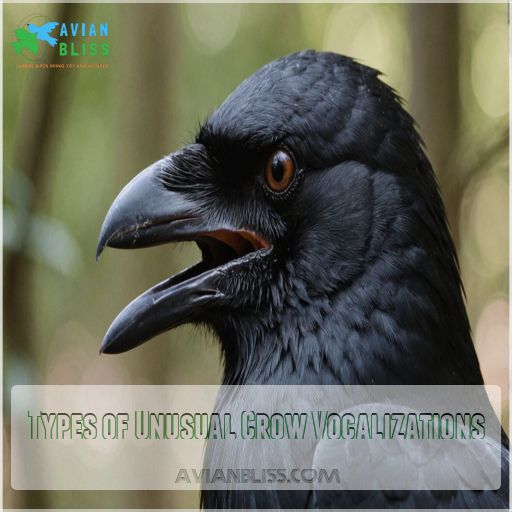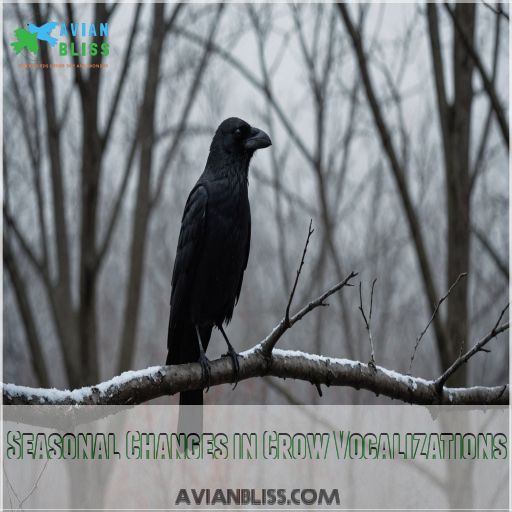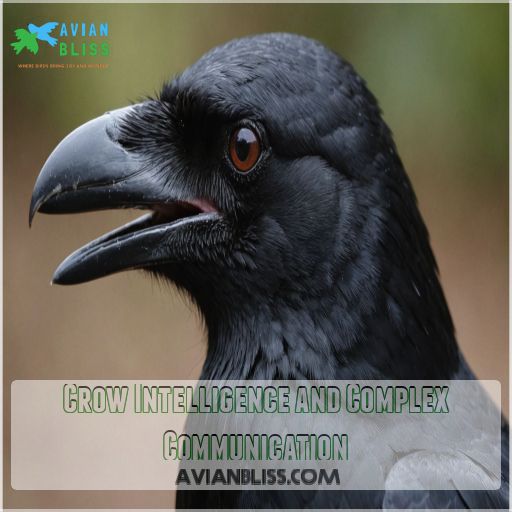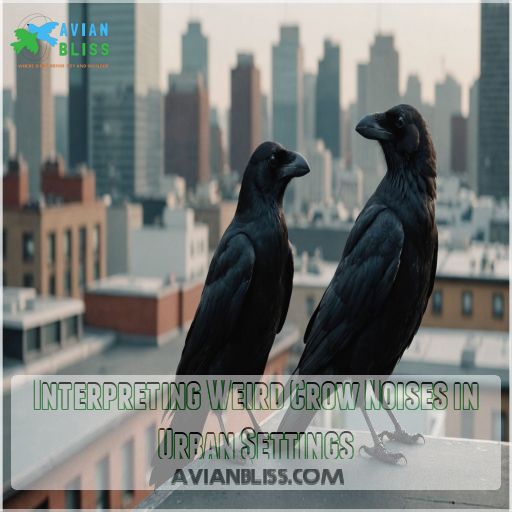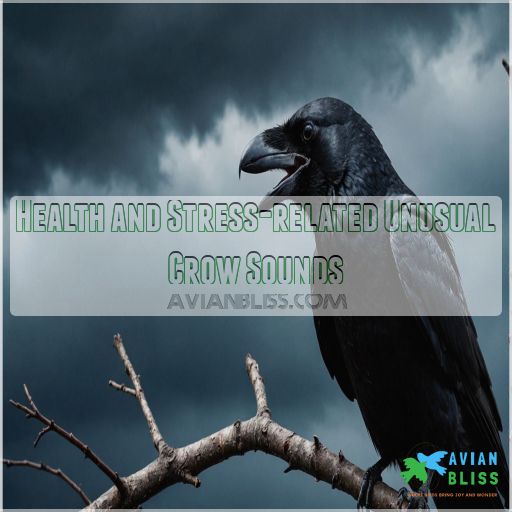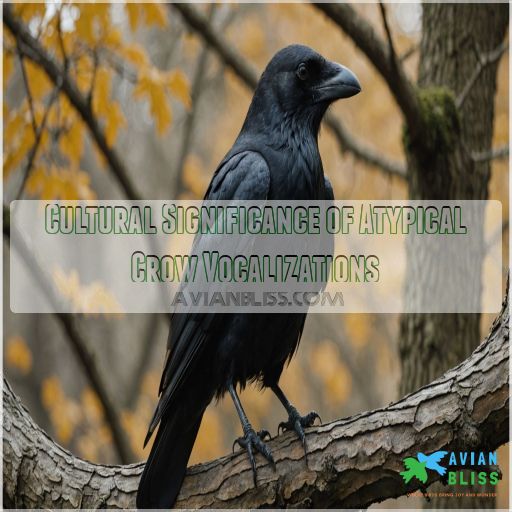This site is supported by our readers. We may earn a commission, at no cost to you, if you purchase through links.

Crows make all sorts of bizarre sounds like gurgles, rattles, and even mimic car alarms or other birds. These odd noises help crows chat with their buddies, announce a dreamy crush (it’s love, after all), or warn off intruders—much like a teen with a "keep out" sign.
They’re vocal geniuses adapting to urban chaos or just voicing some good ol’ crow drama.
Curious how they pull off such a symphony? Stick around for the secrets behind their quirky calls!
Table Of Contents
- Key Takeaways
- Types of Unusual Crow Vocalizations
- Reasons Behind Crows Making Weird Noises
- Seasonal Changes in Crow Vocalizations
- Crow Intelligence and Complex Communication
- Interpreting Weird Crow Noises in Urban Settings
- Health and Stress-related Unusual Crow Sounds
- Cultural Significance of Atypical Crow Vocalizations
- Technological Tools for Analyzing Crow Noises
- Frequently Asked Questions (FAQs)
- What does a rattling Crow sound like?
- What sounds do crows make?
- Why do crows make weird noises?
- Do Crows mimic sounds?
- Why does a crow make a weird noise?
- What do the different crow sounds mean?
- Why do crows go crazy cawing?
- What does it mean when a crow makes a gurgling sound?
- How do crows communicate with each other?
- What do different crow vocalizations mean?
- Can crows learn new sounds or mimic others?
- How do crows use their vocalizations in social interactions?
- Are there any regional variations in crow calls?
- Conclusion
Key Takeaways
- Crows Are Nature’s Soundboard: You’ll find crows mimicking everything from car alarms to dog barks. Just like that friend who can imitate every accent, crows use this skill to adapt to city life and communicate in their complex social circles. It’s their way of staying connected in a noisy world.
- Communication Experts: Crows have a rich vocabulary beyond the simple "caw." Whether they’re gurgling, growling, or rattling, each sound serves a distinct purpose—such as warning their buddies about a nearby hawk or sweet-talking their mate. Think of it as their version of bird Twitter.
- Survival Noises: When danger is afoot, crows step up as the neighborhood watch, making loud, frantic calls to alert the flock. These alarm calls vary depending on the threat, showing just how sophisticated their warning system can be. It’s like having a built-in security alert.
- City-Savvy Birds: Living in urban areas means crows adapt their calls to compete with the hustle and bustle. They might get louder or change their pitch to make sure their messages don’t get drowned out by traffic and construction noise. They’ve got city life figured out.
Types of Unusual Crow Vocalizations
You’ll hear crows make a variety of unusual sounds beyond their typical caws, including gurgles, rattles, and even mimicry of other animals or objects.
These diverse vocalizations serve different purposes, from communication and territorial defense to expressing contentment or distress.
Non-traditional Caws and Calls
Beyond the familiar "caw," crows have a surprising repertoire of non-traditional vocalizations. You might hear:
- Rattles: Quick, staccato sounds used in social interactions
- Growls: Low, guttural noises often expressing displeasure
- Coos: Soft, gentle calls between mates or parents and offspring
- Clicks: Sharp, percussive sounds for close communication
These diverse crow calls serve various purposes in their complex social structure, from warning signals to expressions of affection. Urban environments have even influenced crow dialects, showcasing their adaptability.
Mimicry of Other Sounds
You might be surprised to hear a car alarm or human speech coming from a crow. These clever birds can mimic a variety of sounds, including other bird songs and even predator calls, like those used in vocal emotional communication
. Their ability to imitate stems from their vocal anatomy, brain structure, and behavior.
Let’s explore some examples of crow mimicry:
| Sound Type | Example | Purpose |
|---|---|---|
| Mechanical | Car alarms | Curiosity |
| Human | Speech | Social bonding |
| Animal | Dog barks | Territorial defense |
| Birds | Hawk calls | Mating display |
| Nature | Frog croaks | Learning/play |
Gurgling and Rattling Noises
While crows are known for their caws, they’re also capable of producing gurgling and rattling noises.
These unusual sounds, often described as clicking or knocking, can leave you scratching your head.
The "rattle call" resembles the growl of the Predator from the 1987 movie.
These vocalizations are part of crows’ complex communication system, which includes various calls and even mimicry of other animals.
Distress Calls and Alarm Vocalizations
Crows aren’t just chatterboxes; they’re nature’s security system. Their distress calls and alarm vocalizations serve as key warnings.
When danger lurks, crows let out a cacophony of harsh caws and screeches, alerting the entire flock. These calls vary based on the threat level and type of predator (Source).
It’s noteworthy that urban crows have adapted their alarms, responding differently to human presence compared to their rural counterparts, as they also use their calls to convey the level of threat, making them a vital part of their distress calls and alarm vocalizations.
Reasons Behind Crows Making Weird Noises
You’ve heard those strange noises from crows and wondered what they mean.
Crows produce a variety of unusual sounds for reasons ranging from environmental factors and social interactions to territorial disputes and mating behaviors.
Environmental Factors Influencing Vocalizations
The world around crows shapes their vocal repertoire.
Environmental factors like habitat variation, weather effects, and noise pollution influence crow vocalizations. Urban crows adapt their calls to compete with city sounds, often raising their pitch or volume.
In rural areas, crows may use lower frequencies that travel farther. Seasonal changes also play a role, with breeding season bringing new sounds to the crow’s vocabulary.
These adaptations showcase the remarkable flexibility of crow communication and demonstrate how crows can adapt to different environments, such as urban and rural areas, making them successful in various environmental factors.
Social Interactions and Communication
Social symphony orchestrates the weird noises you hear from crows. They’re not just cawing; they’re engaging in complex communication.
Crows use various vocalizations to interact with their group, maintain bonds, and share information. Their calls can convey different meanings based on timing, pauses, and speed.
- Gentle coos between mated pairs, whispering "I love you"
- Rattles signaling intimate family connections
- Mimicry of over 100 sounds, including human speech
Territorial Disputes and Warnings
Ever heard a cacophony of caws erupting in your neighborhood? You’re likely witnessing territorial disputes among crows. These clever birds use various vocalizations to defend their turf and warn of potential threats, such as hawks and owls, which they’ll aggressively mob to protect their nests and young. This behavior is an example of collective vigilance in action.
Let’s explore the fascinating world of crow communication:
| Call Type | Purpose | Emotional Impact |
|---|---|---|
| Harsh Caws | Boundary Defense | Intimidating |
| Mobbing Calls | Predator Warning | Alarming |
| Rattling Noises | Nesting Disputes | Unsettling |
Understanding these sounds can help you decipher the drama unfolding in your local crow community.
Mating and Courtship Behaviors
Shifting from territorial caws, crow mating antics bring a new soundtrack to their world.
During courtship, crows showcase unique vocalizations and behaviors. You might hear softer, more melodic calls, part of their mating vocalizations.
These soundtracks accompany rituals like courtship feeding and nest building displays, reinforcing pair bonding.
It’s crow romance, with a quirky twist, a demonstration of crow romance .
Seasonal Changes in Crow Vocalizations
As the seasons change, you might notice crows making different noises, each linked to specific times of the year.
These vocalizations, from breeding season caws to migration calls, can offer intriguing insights into their behaviors and survival strategies.
Spring Breeding Season Sounds
Spring’s arrival brings crow nesting activities, filled with unique sounds that you’ve likely noticed.
Crows engage in nest building sounds as they craft their cozy homes. Listen for mating rituals as they establish territories with lively crow communication during their unique cloacal kiss behaviors as part of their complex mating strategies
.
The crow breeding season is also marked by chick begging calls and parental communication, showcasing impressive crow cognition and their vibrant territorial defense.
Summer Fledgling-related Noises
As summer arrives, the once-quiet crow family erupts with a cacophony of fledgling feeding calls, nestling begging sounds, and parent crow vocalizations.
These noisy fledglings, still learning to fly, may emit distress calls or curious first flight sounds as they explore their world.
Observing this seasonal crow communication can provide fascinating insights into their family dynamics. It can also help us understand the cacophony of fledgling feeding calls and the noisy fledglings themselves.
Fall Foraging and Migration Calls
Crow calls change with the seasons.
During fall, crows adjust their vocalizations to communicate about food scarcity, fall foraging routes, and migration patterns.
You might notice varied crow calls as they map their range, facing territorial shifts and preparing for winter roosting.
These calls play an essential role in crow ecology, signaling adaptation for survival and movement.
Winter Roosting and Survival Vocalizations
When winter rolls in, crows get chatty.
Their odd calls are all about survival. You’ll hear them discussing:
- Roosting locations: They scout the best spots.
- Predator alerts: Quick warnings keep everyone safe.
- Food scarcity: Sharing tips on scarce resources.
These vocalizations help them stay warm and united, a vital winter survival strategy.
Crow Intelligence and Complex Communication
You might be surprised to learn that crows, known for their intelligence, use a variety of complex vocalizations to communicate.
Their ability to share information, recognize fellow crows, and even mimic sounds illustrates an advanced form of social interaction and adaptability in their calls.
Tool Use and Problem-solving Vocalizations
Imagine a crow crafting tools, while vocalizing in ways that mirror human problem-solving dialogue. Tool use and vocalizations often intertwine in these intelligent birds.
They might chatter during a successful tool experiment, showcasing their problem-solving skills. Their ability to remember and innovate fascinates scientists, highlighting unique communication efficiency.
| Behavior | Description |
|---|---|
| Tool Use | Crafting and utilizing objects |
| Problem-solving | Finding innovative solutions |
| Vocal Learning | Acquiring new sounds |
| Communication | Sharing strategies |
| Human Interaction | Responding to human cues |
Information Sharing Through Calls
Crows excel at problem-solving and sharing information through their complex calls.
They alert each other to predator warnings, mark food locations, and even maintain social hierarchy.
These intelligent birds use calls during mating rituals and nest defense, showcasing advanced communication skills. In fact, some birds, such as the Blue-gray Gnatcatcher, have even been observed engaging in mobbing behavior against predators, further highlighting their complex social interactions.
Next time you hear their varied calls, you’re actually witnessing impressive crow intelligence and social behavior in action.
Learning and Adapting New Sounds
Crow intelligence is fascinating, especially their ability to learn and adapt new sounds.
Through vocal learning, these birds mimic various noises, whether from nature or urban environments. It’s like they’re nature’s tiny tape recorders, adjusting their bird language to fit new settings.
You might hear a crow mimic a car alarm, showcasing their remarkable crow communication skills.
Individual Crow Recognition in Calls
Did you know crows can recognize the unique calls of their fellow corvids?
This remarkable ability, known as individual vocal recognition, allows them to identify specific group members by their distinct vocalizations.
Researchers have found that crows can discriminate between the contact calls of familiar and unfamiliar individuals, a skill that likely aids in understanding their complex social world .
Interpreting Weird Crow Noises in Urban Settings
In urban settings, you’re likely to hear crows making all sorts of strange noises as they adapt to the bustling city soundscapes.
Factors like human interactions, traffic, and nearby construction play a role in how these vocalizations evolve, revealing the crows’ adaptability and intelligence.
These vocalizations evolve in response to their urban environment, demonstrating the crows’ ability to adjust to new situations.
Adaptation to City Soundscapes
Moving from crow intelligence to urban adaptation, you might notice peculiar noises as part of their strategy to tolerate city sounds.
These changes help them navigate bustling environments.
Urban noise tolerance and adaptation in crow society highlight their resilience.
By altering vocalizations, they manage city noise impacts, improving communication amidst the predictable chaos of city life.
Human-crow Interactions and Vocalization Changes
Just as crows adapt to city life, they also adjust their calls around you. Whether it’s a call for food or mimicking urban noises, these vocalization changes highlight crow-human interactions.
You might notice:
- Mimicked human sounds
- Different food-related calls
- Adaptation to noise pollution
- Enhanced mimicry skills
- Crow urban adaptation
Engage with these clever birds!
Traffic and Construction Noise Influences
In bustling urban soundscapes, crows adapt their calls to overcome traffic noise effects and construction impacts. Your local crow might mimic sounds as part of their unique vocal abilities or adjust its volume to communicate effectively amidst sound pollution
.
This adaptation aids in crow behavior management and communication, ensuring they can still warn each other of threats or signal their presence despite the noisy environment.
Their ability to adapt is also influenced by their natural curiosity and associative learning, allowing them to link between objects and sounds.
Additionally, this behavior is a clear sign of their intelligence and problem-solving abilities, often seen in their innovative approaches to gathering nesting materials.
Food Source Communication in Cities
Crows in cities often engage in what you might call "trash can calls" to inform their community about urban food sources.
These calls, part of the crow dialects, guide others to fruitful city foraging spots.
Although it might sound odd, these vocalizations are key for ensuring crow harmony amid food competition and highlight intricate crow interactions and communication.
Health and Stress-related Unusual Crow Sounds
When crows make unusual noises, it might signal health issues or stress factors like illness, injury, or hunger.
Recognizing these sounds can help you understand if these intelligent birds are experiencing discomfort or reacting to nearby threats.
Illness and Injury Vocalizations
Your feathered friend may be making some odd sounds due to illness or injury, which can sometimes be a sign of a more serious underlying condition, such as seizures or infections that can cause altered behavior patterns.
For example, a bird experiencing a seizure may exhibit unusual vocalizations, head tilting, or difficulty balancing, and in severe cases, may even lead to sudden death, as seen in cases where my bird has a seizure and died.
Distress calls, pain vocalizations, and recovery noises can indicate a health issue. Look for signs like lethargy, loss of appetite, or physical wounds.
Consult an avian vet if the noises persist or your crow seems unwell. With proper care, your crow can get back to its usual cawing in no time.
Predator Presence and Alarm Calls
Moving from illness-related noises, consider what happens when predators appear.
You’ll notice crows making weird noises and alarm calls, activating their crow mobbing protocol.
They communicate with:
- Call variations alerting others.
- Alarm duration indicating threat level.
- False alarms ensuring readiness.
These sounds display crow hierarchy, leadership, and cooperation, safeguarding their community from various predator types.
Hunger and Food-related Noises
When those crows start chattering up a storm, it might just be their way of saying, "Feed me!" Hungry crows use food-related calls and begging noises to alert others.
They compete for scarce resources, playing a key role in crow agriculture and diet.
| Sound Type | Purpose | Effect on Flock |
|---|---|---|
| Begging Noises | Signal hunger | Attracts attention |
| Food-related Calls | Locate food | Guides scavenging |
| Scavenging Sounds | Share food location | Increase cooperation |
| Territorial Defense | Protect resources | Deters competition |
Cultural Significance of Atypical Crow Vocalizations
When you hear crows making unusual noises, it might surprise you to know these sounds hold cultural significance across different societies.
From superstitions and folklore to scientific studies, these atypical vocalizations offer a fascinating glimpse into both human interpretations and ecological insights.
Folklore and Superstitions About Crow Calls
Crows, with their unsettling calls, often stir thoughts of crow omens and bad luck.
Across cultures, these vocalizations tie into crow folklore, symbolizing death or prophecy.
For instance, a single crow’s call might signal impending doom, yet seeing two could bring good fortune.
Ancient bird language practices also associate atypical crow sounds with messages from the divine .
Literary and Artistic Representations
Literature and art often celebrate crows, with atypical vocalizations adding layers to their mystique.
You see crows in literature embracing their roles as harbingers or guides. In art, these sounds inspire deep symbolism, reflecting mystery and intelligence.
Crow metaphors abound, enhancing their appreciation and highlighting their mythical status, showcasing their cultural significance in a crow group or crow flock.
Scientific Studies on Crow Language
Following artistic representations, scientific studies on crow language reveal intriguing communication complexity.
Researchers analyze crow dialects, sound patterns, and vocal learning to understand crow grammar and language.
Crows use these vocalizations for social connections and benefits.
This unique communication, explored through sound analysis and natural language processing, suggests a bright crow future filled with contentment and harmony.
Ecological Indicators in Crow Sounds
Intrigued by those odd crow calls?
Their unique vocalizations can actually reveal important insights about the environment.
For instance, changes in habitat or food scarcity may prompt crows to make unfamiliar sounds as they adapt.
These atypical cries could even serve as early warning signals, alerting us to ecological shifts we should address.
So next time you hear a peculiar crow call, listen closely – it might just be nature’s way of communicating with us, giving us a chance to address these ecological shifts.
Technological Tools for Analyzing Crow Noises
When you’re curious about the peculiar sounds crows make, technological tools can offer fascinating insights.
From bioacoustic recording devices to AI-driven analysis, these innovations help decode the complex vocalizations that make crows such intriguing creatures, specifically their vocalizations.
Bioacoustic Recording Devices
As researchers explore crow vocalizations, cultural insights blend seamlessly with science.
To better understand these intricate calls, use bioacoustic recording devices. They help you in crow call analysis by capturing sounds for bioacoustic data collection
.
Whether you’re recording crow dialects for a sound library creation or joining citizen science projects, these gadgets are a goldmine for enthusiasts (Source).
Spectogram Analysis of Crow Calls
You’ve recorded crow calls, now picture them with spectrogram analysis. This method helps you visualize crow call variations by producing an image of the sound frequency and call patterns. It’s like watching a crow’s vocal communication dance across a chart, revealing their acoustic diversity in striking detail.
Such tools unravel the mysteries behind their chirps and caws, including the non-vocal sounds that birds create, like drumming or rustling of leaves, which can be identified using these technological tools learn bird sounds.
By analyzing the various sounds made by crows, we can gain a deeper understanding of their language and behavior.
AI and Machine Learning in Vocalization Studies
After analyzing spectrograms, you might wonder how to categorize those crow calls.
AI and machine learning come into play, offering tools to classify crow calls and study their language. These technologies can examine patterns, identify dialects, and build detailed databases.
- Better crow call classification
- AI-driven crow language
- Machine learning for crow dialects
- Robust crow vocalization database
Citizen Science Projects on Crow Sounds
Imagine you’re curious about crow calls, and a citizen science app comes to the rescue.
Join projects that create a crow vocalization database, contributing to a vast crow sound library.
These initiatives help with crow sound mapping and explore crow song dialects.
It’s like being part of a team uncovering a secret language project.
Frequently Asked Questions (FAQs)
What does a rattling Crow sound like?
A crow’s rattling call resembles a series of rapid, harsh clicks, akin to the growl of the Predator from the 1987 movie.
It’s an intriguing sound, sometimes startling, used in diverse social contexts.
What sounds do crows make?
Crows produce an astonishing variety of sounds, including loud caws, rattles, growls, and coos.
They’re decent mimics, sometimes imitating human voices or car alarms.
These vocalizations help communicate danger or establish territory.
Why do crows make weird noises?
You’ll notice crows produce a variety of sounds.
Including rattles, growls, coos, and odd noises.
Which can be used for communication, mimicking other animals or humans, and even expressing emotions or warning calls.
Do Crows mimic sounds?
American crows have at least 250 different calls.
They are skillful sound mimics, rivaling parrots.
They’ll mimic human voices, other animals, and sounds, often adding a surprising twist to their already impressive vocal range.
This is showcased in their ability to mimic human voices, as well as other sounds.
Why does a crow make a weird noise?
A crow makes a weird noise when it’s mimicking sounds, communicating with other crows, or expressing emotions.
These vocalizations can range from clicking and cooing to growling, often serving purposes like mating or alerting others.
These purposes can include mating or alerting others (Source).
What do the different crow sounds mean?
A crow’s vocalizations can range from simple "caws" to complex rattles, growls, and coos, each carrying distinct meanings based on context.
They signal territory, safety, and connections within their group, acting like neighborhood chat alerts.
Why do crows go crazy cawing?
When encountering a loud, chaotic crow gathering, it’s likely they’re communicating about food, territory, or danger.
Think of it as their version of social media, where they share info and alert others.
What does it mean when a crow makes a gurgling sound?
A crow’s gurgling sound might indicate affection or communication with nearby crows.
This sound is often soft, resembling a purr, and is less understood scientifically.
It could involve social bonds, possibly indicating comfort or curiosity.
How do crows communicate with each other?
Crows communicate using various vocalizations, including caws, rattles, and coos.
These sounds convey different messages depending on their rhythm, pitch, and repetition.
They’re social creatures, using calls to warn of danger or maintain family bonds.
What do different crow vocalizations mean?
For instance, a crow’s "caw" can convey different meanings – it may simply be a casual companion call or signal an alarm about a nearby predator.
Understanding the nuances in their vocalizations takes keen observation and practice, requiring a developed skill for keen observation.
Can crows learn new sounds or mimic others?
Sure, crows can learn new sounds and mimic others, including human voices and various animal noises.
Captive crows are more likely to mimic due to more exposure, while wild crows might mimic sounds for social reasons.
How do crows use their vocalizations in social interactions?
In social interactions, crows use vocalizations to communicate warnings, assert dominance, and coordinate group activities.
Like mobbing predators or signaling food availability, these behaviors serve a purpose.
These vocal adaptations enhance social cohesion and individual recognition within their complex communities.
Are there any regional variations in crow calls?
Crows exhibit regional variations in their calls.
These differences can result from ancestral hybridization and geographic separation, creating distinct accents similar to human dialects.
For instance, crows in the Pacific Northwest have particularly deeper, harsher calls , which can be considered as distinct accents.
Conclusion
Imagine you’re surrounded by a symphony of bizarre sounds—it’s just the crows having a chat!
Whether it’s a crow making a weird noise to warn about a predator, woo a partner, or discuss a juicy piece of roadkill, there’s always a reason behind their calls.
The urban and natural worlds shape their unique vocalizations, offering endless intrigue.
So next time you hear these feathered friends, you’re in on their secret audio drama.
Keep listening to the symphony of bizarre sounds!

